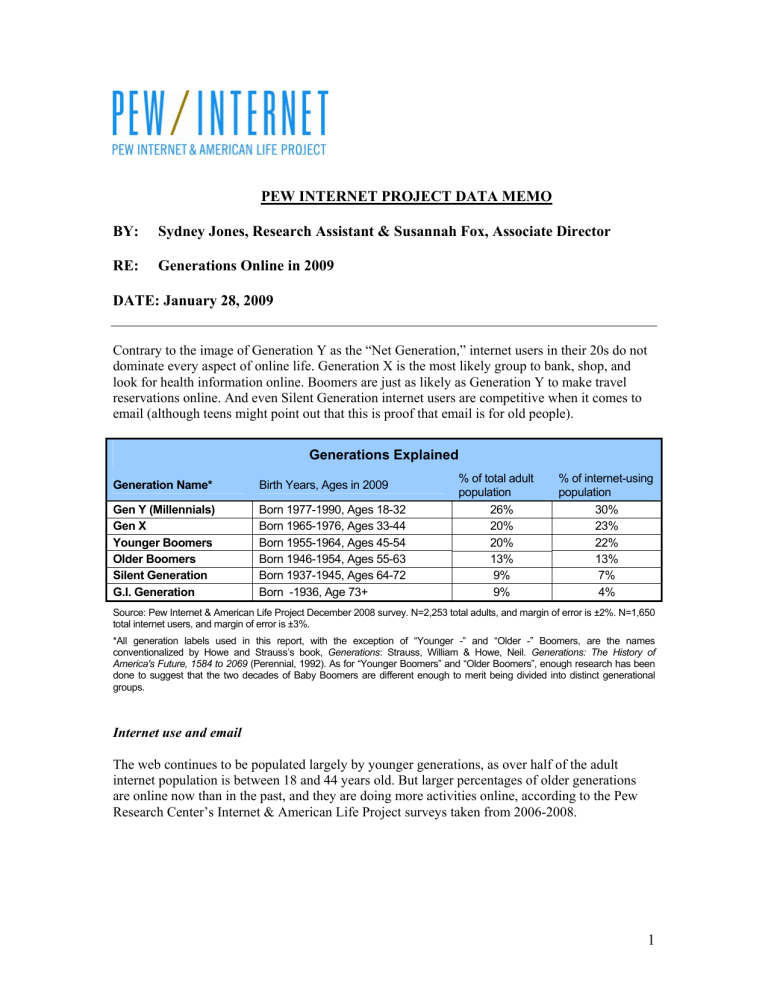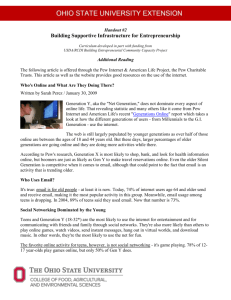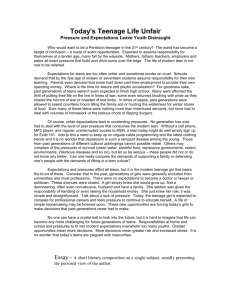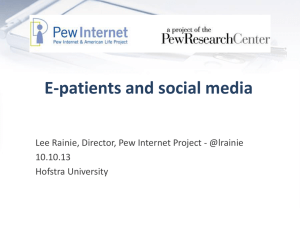PEW INTERNET PROJECT DATA MEMO BY:

PEW INTERNET PROJECT DATA MEMO
BY: Sydney Jones, Research Assistant & Susannah Fox, Associate Director
RE: Generations Online in 2009
DATE: January 28, 2009
Contrary to the image of Generation Y as the “Net Generation,” internet users in their 20s do not dominate every aspect of online life. Generation X is the most likely group to bank, shop, and look for health information online. Boomers are just as likely as Generation Y to make travel reservations online. And even Silent Generation internet users are competitive when it comes to email (although teens might point out that this is proof that email is for old people).
Generations Explained
Generation Name*
Gen Y (Millennials)
Gen X
Younger Boomers
Older Boomers
Silent Generation
G.I. Generation
Birth Years, Ages in 2009
Born 1977-1990, Ages 18-32
Born 1965-1976, Ages 33-44
Born 1955-1964, Ages 45-54
Born 1946-1954, Ages 55-63
Born 1937-1945, Ages 64-72
Born -1936, Age 73+
% of total adult population
26%
20%
20%
13%
9%
9%
% of internet-using population
30%
23%
22%
13%
7%
4%
Source: Pew Internet & American Life Project December 2008 survey. N=2,253 total adults, and margin of error is ±2%. N=1,650 total internet users, and margin of error is ±3%.
*All generation labels used in this report, with the exception of “Younger -” and “Older -” Boomers, are the names conventionalized by Howe and Strauss’s book, Generations : Strauss, William & Howe, Neil. Generations: The History of
America's Future, 1584 to 2069 (Perennial, 1992). As for “Younger Boomers” and “Older Boomers”, enough research has been done to suggest that the two decades of Baby Boomers are different enough to merit being divided into distinct generational groups.
Internet use and email
The web continues to be populated largely by younger generations, as over half of the adult internet population is between 18 and 44 years old. But larger percentages of older generations are online now than in the past, and they are doing more activities online, according to the Pew
Research Center’s Internet & American Life Project surveys taken from 2006-2008.
1
M akeup of Adult Internet Population by Generation
(does not include teens)
Gen Y
(ages 18-32)
30%
Gen X
(ages 33-44)
23%
G.I. Generation
(age 73+)
4%
Silent Generation
(ages 64-72)
7%
Older Boomers
(ages 55-63)
Younger
Boomers
(ages 45-54)
22%
13%
The biggest increase in internet use since 2005 can be seen in the 70-75 year-old age group.
While just over one-fourth (26%) of 70-75 year olds were online in 2005, 45% of that age group is currently online. Much as we watch demographic and age groups move up in “degrees of access” on our “thermometers,”
1
we can probably expect to see these bars become more level as time goes on. For now, though, young people dominate the online population.
Chart: Percentage of Americans online by age (Teens, 12-17, Nov. 2007-Feb. 2008, margin of error =
±3%. Adults, December 2008, margins of error differ by subgroup. See methodology).
100%
90%
80%
70%
60%
50%
40%
30%
20%
10%
93%
87%
89%
82%
85%
85%
87%
83%
80%
80%
83%
76%
80%
73%
78%
68%
71%
68%
62%
55%
57% (2005)
56% (2008)
45%
26%
27%
17%
0%
12-17 18-24 25-29 30-34 35-39 40-44 45-49 50-54 55-59 60-64 65-69 70-75 76+
2008 2005
Instant messaging, social networking, and blogging have gained ground as communications tools, but email remains the most popular online activity, particularly among older internet users. Fully
1
“Degrees of Access” (Pew Internet & American Life Project, May 2008) Available at: http://pewinternet.org/PPF/r/251/presentation_display.asp
2
74% of internet users age 64 and older send and receive email, making email the most popular online activity for this age group. At the same time, email has lost some ground among teens; whereas 89% of teens claimed to use email in 2004, just 73% currently say they use email.
Teens and Generation Y find entertainment and social networks online
Teens and Generation Y (internet users age 18-32) are the most likely groups to use the internet for entertainment and for communicating with friends and family. These younger generations are significantly more likely than their older counterparts to seek entertainment through online videos, online games, and virtual worlds, and they are also more likely to download music to listen to later. Internet users ages 12-32 are more likely than older users to read other people’s blogs and to write their own; they are also considerably more likely than older generations to use social networking sites and to create profiles on those sites.
2
Younger internet users often use personal blogs to update friends on their lives, and they use social networking sites to keep track of and communicate with friends.
3
Teen and Generation Y users are also significantly more likely than older generations to send instant messages to friends.
By a large margin, teen internet users’ favorite online activity is game playing; 78% of 12-17 year-old internet users play games online,
4
compared with 73% of online teens who email, the second most popular activity for this age group. Online teens are also significantly more likely to play games than any other generation, including Generation Y, only half (50%) of whom play online games.
Older generations use the internet as a tool for research, shopping and banking
Compared with teens and Generation Y, older generations use the internet less for socializing and entertainment and more as a tool for information searches, emailing, and buying products. In particular, older internet users are significantly more likely than younger generations to look online for health information. Health questions drive internet users age 73 and older to the internet just as frequently as they drive Generation Y users, outpacing teens by a significant margin. Researching health information is the third most popular online activity with the most senior age group, after email and online search.
Internet users ages 33-72 are also significantly more likely than younger users to look online for religious information and they are more likely to visit government websites in search of information.
Generation X (internet users ages 33-44) continues to lead in online shopping. Fully 80% of
Generation X internet users buy products online, compared with 71% of internet users ages 18-
32. Interest in online shopping is significantly lower among the youngest and oldest groups; 38%
2
For more on adults’ use of social networking sites, see “Adults and Social Network Websites” (Pew
Internet & American Life Project, January 2008) Available at:
3 http://www.pewinternet.org/PPF/r/272/report_display.asp
For more on teens’ use of social media, see “Teens and Social Media” (Pew Internet & American Life
4
Project, December 2007) Available at: http://pewinternet.org/PPF/r/230/report_display.asp
.
For more on teens and gaming, see “Teens, Video Games and Civics” (Pew Internet & American Life
Project, September 2008) Available at: http://pewinternet.org/PPF/r/263/report_display.asp
.
3
of online teens buy products online, as do 56% of internet users ages 64-72 and 47% of internet users age 73 and older.
Generation X internet users have also maintained their edge in online banking, as they are significantly more likely than any other generation to do their banking online (67%). As
Generation Y users get older, however, they have grown much more likely to bank online as well: the percentage of online Generation Y to do their banking online is up from 38% in 2005 to 57% in 2008. There has been no significant growth among older generations when it comes to banking online.
Video downloads, online travel reservations, and work-related research are now pursued more equally by young and old
A few online activities that were previously dominated by either older generations or younger generations are now being done more equally across all generations under 73 years old. One such activity is downloading videos, an activity that in 2005 was significantly more popular with teens and Generation Y than with any other generation. Generation X is catching up, as 31% of that generation claim to download videos as of 2007, compared with 38% of Generation Y.
Generations on the oldest end of the spectrum also became significantly more likely than they had been two years before to download videos. Some 13% of G.I. Generation internet users (age 73+) reported downloading videos, up from 1% in 2005, and another 13% of the online Silent
Generation (ages 64-72) say they download videos, up from 8% in 2005.
Perhaps less surprisingly, Generation Y is also gaining significant ground in some activities previously dominated by Generation X and older. In addition to becoming more likely to do banking online, Generation Y has also grown more likely to make their travel reservations online.
In 2005, half (50%) of Generation Y internet users had booked travel arrangements online, and, in
2008, that number rose to 65%. During the same time, the percentages of Generation X and older generations to make online travel reservations remained about the same.
The workplace online network is expanding to include more Generation Y users.
5
Internet users
18-32 are going online more than ever to do research for their jobs. In 2007, 51% said they used the internet for their jobs other than for email, compared with 44% of the same group in 2005.
5
For more on internet use in the workplace, see “Networked Workers” (Pew Internet & American Life
Project, September 2008) Available at: http://pewinternet.org/PPF/r/264/report_display.asp
.
4
Generational Differences in Online Activities
Online
Teens a
(12-17)
Gen Y
(18-32)
Gen X
(33-44)
Younger
Boomers
(45-54)
Older
Boomers
(55-63)
Silent
Generation
(64-72)
G.I.
Generation
(73+)
All
Online
Adults b
Go online 93% 87% 82% 79% 70% 56% 31% 74%
Teens and Gen Y are more likely to engage in the following activities compared with older users:
Play games online
Watch videos
78
57
50 38 26 28
72 57 49 30
25
24
18 35
14 52 online
Get info about a
30
~
64 55 43 36 11 10 47 job
Send instant
68 59 38 28 23 25 18 38 messages
Use social
65 67 36 20 9 11 4 35 networking sites
Download music 59 58 46 22 21 16 5 37
Create an SNS profile
Read blogs
Create a blog
55
49
28
60 29 16
43 34 27
20 10 6
9
25
7
5
23
6
4
15
6
29
32
11
Visit a virtual world 10 2 3 1 1 1 0 2
Activities where Gen X users or older generations dominate:
Get health info 28
Buy something online
38 71 80 68 72 56 47 71
Bank online *
Visit gov’t sites *
Get religious info 26
~
31 38 42 30 30 26 35
And for some activities, the youngest and oldest cohorts may differ, but there is less variation overall:
Use email 73
Use search engines
* 90 85 70 89
Research products * 84 84 82 79
Get news 63 74 76 70 69
Make travel reservations
* 65
73
56
69
60
37
81
70
65 68
Research for job * 51 33 9 51
Rate a person or product
* 37
Download videos 31
~
25 16 32
38 31 21 16 13 13 27
Participate in an online auction
Download podcasts
* 26
19 25 21 19 12
16
10
6
10
26
19 a
Source for Online Teens data: Pew Internet & American Life Project Surveys conducted Oct.-Nov. 2006 and Nov. 2007-Feb. 2008. Margin of error for online teens is ± 4% for
Oct.-Nov. 2006 and ±3% for Nov. 2007-Feb. 2008. b
Source for Online Adult data: Pew Internet & American Life Project Surveys conducted August 2006, Feb.-March 2007, Aug.-Sept. 2007, Oct.-Dec. 2007, May 2008, August
2008, November 2008, and December 2008. Margin of error for all online adults is ±3% for these surveys. The average margin of error for each age group can be considerably higher than ± 3%, particularly for the “Matures” and “After Work” age groups. See Methodology for average margins of error for each generational group.
~
Most recent teen data for these activities comes from the Pew Internet & American Life Project Teens and Parents Survey conducted Oct.-Nov. 2004. Margin of error is ± 4%.
* No teen data for these activities.
Broadband access has doubled for many age groups, tripled in oldest groups
Since 2005, broadband access has increased dramatically in the United States across all age groups, but older groups are still largely unconnected to high-speed internet. For Americans ages
12-24, broadband access has increased by about half; for 25-64 year olds, it has about doubled; and for seniors 65 and older, broadband access has more than tripled. The percentage of the oldest age group to have broadband at home is still very low, however, at just 16%.
5
Chart: Percentage of all Americans with broadband at home by age (Teens, 12-17, Nov. 2007-Feb.
2008, margin of error = ±3%. Adults, December 2008, margins of error differ by subgroup. See methodology.).
50%
40%
30%
20%
10%
0%
100%
90%
80%
70%
60%
100%
90%
80%
70%
68%
69%
68%
71%
68%
67%
66%
60%
58%
60%
48%
50%
42%
49%
40%
40% 40%
42%
31%
30%
36%
35% 36%
32%
20%
27%
16%
23%
10%
13%
8% 4%
0%
12-17 18-24 25-29 30-34 35-39 40-44 45-49 50-54 55-59 60-64 65-69 70-75 76+
2008 2005
Chart: Percentage of home internet users with broadband at home (Teen internet users, 12-17, Nov. 2007-
Feb. 2008, margin of error = ±4%. Adults, December 2008, margins of error differ by subgroup. See methodology.).
80%
89%
88%
89%
88%
87%
88%
82%
83%
79%
83%
78%
70%
12-17 18-24 25-29 30-34 35-39 40-44 45-49 50-54 55-59 60-64 65-69 70-75 76+
2008, internet users
Always-on, high-speed connections make it more convenient for internet users to participate in online activities, and broadband users are significantly more likely than dial-up users to do almost all major online activities.
6
When looking at internet users who go online from home in 2008, broadband is more equally accessed by all age groups; 70% of home internet users older than 75
6
For more on broadband access, see “Home Broadband 2008” (Pew Internet & American Life Project, July
2008) Available at: http://pewinternet.org/PPF/r/257/report_display.asp
.
6
years old have high-speed access. As broadband access continues to increase for all age groups, perhaps we will see increased internet activity, particularly among the trailing older generations.
About the Pew Research Center’s Internet & American Life Project
The Pew Internet Project is an initiative of the Pew Research Center, a nonprofit “fact tank” that provides information on the issues, attitudes and trends shaping America and the world. The Pew
Internet Project explores the impact of the internet on children, families, communities, the work place, schools, health care and civic/political life. The Project is nonpartisan and takes no position on policy issues. Support for the project is provided by The Pew Charitable Trusts.
7
Methodology
The results of this survey are based on data from a series of telephone interviews conducted by
Princeton Survey Research Associates International primarily between August 2006 and August
2008. For all results based on adult internet users, the margin of error is ±3%. For results based on teen internet users (ages 12-17), conducted in October-November, 2004, and October-
November, 2006, the margin of error is ±4%. For results based on teen internet users, conducted in November 2007-February, 2008, the margin of error is ±3%. The margin of error for each generational subgroup shown in the table on page four and discussed throughout the report, however, can be considerably higher than that for the sample of all internet users. Below is a list of the average margins of error for each age group listed in the table:
Average Margins of Error by Age Group
Generational age breaks:
Age breaks in charts:
18-24
25-29
30-34
35-39
40-44
45-49
50-54
55-59
60-64
65-69
70-75
76+
Generation Y (ages 18-32)
Generation X (ages 33-44)
Younger Boomers (ages 45-54)
Older Boomers (ages 55-63)
Silent Generation (ages 64-72)
G.I. Generation (age 73+)
Charts 1 & 2:
MOE for % of all
Americans
±8%
±9%
±9%
±9%
±8%
±7%
±7%
±7%
±8%
±8%
±9%
±7%
MOE for % of internet users
±7%
±6%
±6%
±7%
±8%
±10%
Chart 3: MOE for
% of home internet users
±9%
±10%
±11%
±11%
±9%
±8%
±8%
±8%
±11%
±12%
±14%
±15%
For more information about the latest trends in internet use, please see http://pewinternet.org/trends.asp
.
For more information about the sample of 12-17-year-olds, please see the “Teens and Social
Media” report (available at http://pewinternet.org/PPF/r/230/report_display.asp
).
In addition to sample error, question wording and practical difficulties in conducting telephone surveys may introduce some error or bias into the findings of opinion polls.
The sample for this survey is a random digit sample of telephone numbers selected from telephone exchanges in the continental United States. The random digit aspect of the sample is used to avoid “listing” bias and provides representation of both listed and unlisted numbers
(including not-yet-listed numbers). The design of the sample achieves this representation by random generation of the last two digits of telephone numbers selected on the basis of their area code, telephone exchange, and bank number.
8
Non-response in telephone interviews produces some known biases in survey-derived estimates because participation tends to vary for different subgroups of the population, and these subgroups are likely to vary also on questions of substantive interest. In order to compensate for these known biases, the sample data are weighted in analysis. The demographic weighting parameters are derived from a special analysis of the most recently available Census Bureau’s Annual Social and Economic Supplement (March 2007). This analysis produces population parameters for the demographic characteristics of adults age 18 or older, living in households that contain a telephone. These parameters are then compared with the sample characteristics to construct sample weights. The weights are derived using an iterative technique that simultaneously balances the distribution of all weighting parameters.
9




